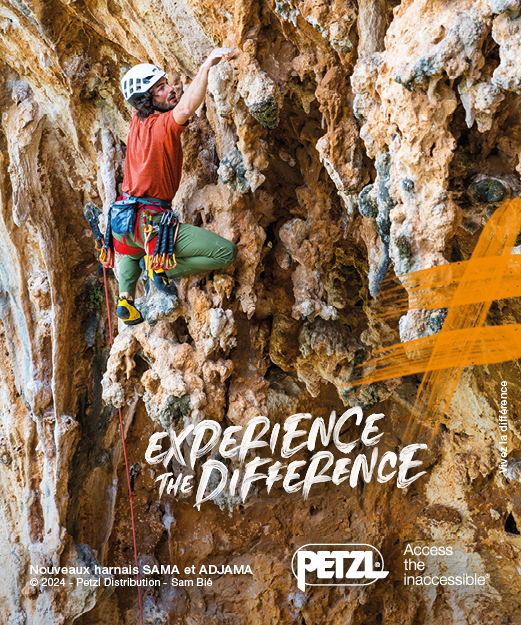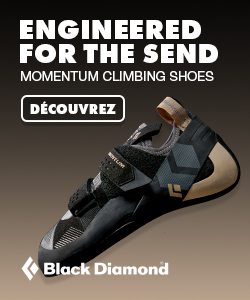Sport climbing, a sport in the age of gaming?

Climbing, like many sports, has entered the era of gaming and connected objects for several years now. From bracelets to beams or holds equipped with force sensors, including walls and even augmented cliffs, digitalization is increasingly present and plays a role in the evolution of our activity.
Technology and sports
So, is this trend a deep-rooted wave? In a few years, will climbers routinely share, across thousands of kilometers, not only boulder problems but also entire routes or their biometric data?
Will everyone systematically monitor, as is already the case for many cyclists or runners, their power data, forearm endurance threshold, or even muscular oxygenation rates during exercise? Or are we witnessing a massive but temporary trend?
Moreover, what is the real added value of technology in the daily climbing experience for most climbers?
Gaming: from sport to play
The technologization of sport is not a recent phenomenon per se. But the proliferation of connected objects, coupled with applications, websites, and even practice spaces, has led to an increasingly pronounced convergence between sport and gaming [1]. Anyone can now easily access services that allow them to organize or practice their sport, join a program to help them progress, or simply integrate into a community.
Which applications?
This gamification thus impacts the sports experience in several ways.
Individually, the ability to quantify and record one’s own activity can foster autonomy. This autonomy varies depending on age. For younger people, digital quantification tools can meet a need for regulating an unstable life, while for working professionals or older individuals, these tools are used for rationalizing and harmonizing personal, professional, and domestic lives, or even for risk prevention [2].
Moreover, virtual reality can allow for an “enrichment” of practice. For instance, the Zwift application, which became hugely popular during the 2020 lockdowns. Perched on their indoor trainer in their laundry room or garage, cyclists power through their sessions and sweat. But they are no longer “alone”! Thanks to the app’s generated visuals, they can mentally immerse themselves in an exotic city, surrounded by a peloton of peers. A great motivator!
Closer to climbing, tools like Kilter and Moonboard have digitized climbing walls, allowing climbers to share routes and compete remotely, virtually. This is made even easier through social networks like Instagram, where they can post videos of their sessions.
Additionally, the blurring boundaries between sports and health are heightened by self-measurement devices like Supersapiens ([]). Developed by a former pro cyclist with diabetes, Supersapiens provides real-time blood glucose data to optimize nutrition during and after effort—for about €150/month. Very useful for wealthy cyclists, triathletes, or trail runners!
Digitalization also redefines how climbing is practiced. Luxov installations illustrate this best. It introduces an entirely new practice paradigm where the focus shifts from ascending to solving purely playful challenges.
The connected objects market
In 2022, no fewer than 135 million smartwatches were sold (30 million in 2015).
Sports represent a prime target for these products, with running constituting the largest market share.
Of course, each connected object comes with premium services, via applications that assist users or help interpret raw data provided by the device. Surprisingly, these premium services do not generate a significant portion of the revenue tied to digitalization.
It’s the data that is lucrative! Given the large user base and associated personal data, the market, initially dominated by startups or specialized SMEs, is now controlled by the GAFAM giants. They aim to build user trust in digital devices, particularly through co-construction strategies, where users contribute to algorithm development by integrating their own metrics [3].

Data exploitation also transcends financial interests. For example, data collected by Strava is highly valuable for urban planners to better understand soft mobility patterns in major cities.
Currently, the French market for connected objects includes general equipment manufacturers (like Le Coq Sportif), accessory brands (like Rossignol), large operators (like Orange), consumer electronics companies (like Archos), and specialized startups. In climbing, the startup Smartboard, led by Laurent Vigouroux and Clément Lechaptois, is a notable example.
For or against the digitalization of sports practice?
Everyone’s relationship with digital tools depends on their age, education, and environment. Rather than deciding whether to be for or against the digitalization of sports, we focus on the added value these connected devices bring to users.
In the perspective of improving performance, the central point in using connected objects lies in the quality of the collected information and its exploitation to better control training. This is often where the problem arises: some devices can only provide approximate data, sometimes useless for athletes. Moreover, interpreting raw data requires a certain level of knowledge and skill.
On the other hand, some note the negative effects of continuous use of these devices. Athletes may sometimes identify themselves with the data collected, to the detriment of real sensations. In extreme cases, they may refuse to train simply because they forgot their smartwatch at home or its battery is dead.

For a healthy use of connected objects and digital tools, the challenge lies in combining objective indicators with real sensations during practice to reduce the risk of dependency—on the app or “their” community. Sometimes, gaining Kudos or earning a KOM becomes an end in itself, a quest for recognition.
To draw a parallel in climbing, consider the example of a well-known Scandinavian website that allows climbers to share their tick lists and engage in virtual competition. Beyond the inevitable cheating (as there is no verification), this encourages some climbers to “justify” every climbing session by logging a tick, even an insignificant one. Route selection is thus driven by the number of points it will earn rather than personal goals.
Being connected does not solve all problems.
This is reflected in the high abandonment rate of this family of devices. Statistics show that after six months of use, nearly one-third of smartwatch users stop using them. This figure rises to 50% after 18 months. Could it be that the measured data is meaningless? Or is it too difficult to interpret?

Climbing and digitalization
In climbing, as in other sports, the use of electronics has existed for over 20 years. For instance, the integration of climbing holds with force sensors began in the 1990s in the UEREPS laboratory in Grenoble. The goal was to better understand climbers’ movement patterns. Such sensors are still used today, particularly on speed holds, allowing coaches to optimize climbers’ motor skills.

Today, beyond pure research, digitalization affects several interconnected areas:
Inclusion
In the early 2000s, an experiment in the Vosges aimed to facilitate climbing access for visually impaired individuals. The system relied on transponders installed near holds. Climbers, equipped with receiver bracelets, could locate holds more easily.
Immersion
Starting in 2015, devices integrating virtual reality appeared. The objectives can be purely recreational, but not exclusively: virtual reality can also be used to help climbers overcome their fear of falling.
Performance
Beam systems and force sensors
This is a rapidly evolving field, though not without failures. The Climbax project, developed by the Swiss brand Mammut, aimed to allow climbers to digitally record their activity using two simple bracelets equipped with accelerometers connected to a smartphone app. Unfortunately, the initiative ended almost as soon as it began.

The appearance of the Smartboard, and later its MySmartboard version, marked a major leap in performance tracking. As previously mentioned, this beam, derived directly from fundamental research, allows climbers to assess physical capabilities in standardized and controlled conditions. It also enables users to build their own training protocols and monitor their progress.
Other connected beams have since been developed, following the Smartboard model. A notable example is the Climbro, perhaps the most advanced iteration. This sleek and elegant beam includes some Smartboard features but primarily targets finger strength. Its intuitive and accessible dedicated app adds a gaming element, appealing to a broader user base.

The Tindeq represents the most affordable entry in this category. It allows climbers to start collecting useful data for their improvement without breaking the bank.

Smartwatches
Accompanying the rise of climbing, major smartwatch brands have integrated climbing-specific features—overlooking the fact that, unlike cycling or running, heart rate is not particularly useful for climbers. Thus, Garmin and Suunto fall short. Only Coros continues to develop features specific to climbing: manual note-taking, grade integration, fall detection, and the number of attempts on a boulder or route. These parameters can be useful for tracking progress and fitness. Not to mention the ultimate accessory: a carabiner that attaches the watch to your harness, freeing the wrist—much more convenient for crack climbing 😊.

Recreational climbing
The Luxov concept is based on a simple idea: equipping each hold with LEDs controlled remotely. Luxov’s purpose is recreational and educational.
For climbers focused on training intensity, tools like Piton Equipment, Kilter or Moonboard are more suitable. Whether adjustable or fixed, equipped with wooden or resin holds, these modern walls revive the charm of 1990s climbing boards. The joy of creating new problems in a small space and sharing them with a community has returned—just with a modern twist. Instead of a notebook, there’s now a dedicated app. The number of setters and shared problems has multiplied.
Management and safety
Let’s take a step to the side while remaining in the digital field. As we described in a previous article, climbing gyms are increasingly using dedicated applications to manage route setting, better understand climber flow, and build loyalty through a community-focused approach. AI is gradually creeping into the work of route setters.
And, to compensate for human shortcomings, companies like Walltopia are developing monitoring systems that also rely on artificial intelligence.
Why not, then, imagine a day when all gyms will equip clients with connected wristbands capable of warning them, through a monitoring system, in case of errors or dangerous behavior…
Conclusion
What can we expect from connected devices today?
By allowing users to create and share their own problems through an app, digitalized walls have revived training board practice and its creative aspects, which were somewhat lost in commercial bouldering gyms.
Similarly, systems like Luxov offer a playful way to experience climbing, enabling a fresh approach to the sport and redefining some learning methods—much like virtual immersion tools.
While the over-sanitization of these devices neglects essential aspects of climbing, such as risk management, it makes the sport more inclusive.
From a performance-monitoring perspective, the real value of connected tools remains debatable. The average level of regular climbers in France is below 6c. For most climbers aiming to improve, refining technique is far more critical than building resistance.
That said, even without aiming for elite performance, using a connected beam or a smartwatch to track session metrics can help climbers better understand their bodies and progress.
The key lies in finding the right balance and not becoming slaves to the technology.
- [1] Schoeny A et Chaboche J (2022). La gamification du sport. L’expérience croisée du pratiquant et du spectateur connectés à l’espace de jeu. Sciences sociales et sport 2022/1, 61-97.
- [2] Dagiral E, Dessajan S, Legon T, Martin O, Pharabod A-S et Proulx S (2019). Faire place aux chiffres dans l’attention à soi. Une sociologie des pratiques de quantification et d’enregistrement aux différents âges de la vie. Réseaux 2019/4, 119-156.
- [3] Calvignac C (2021). Traductions sociotechniques des principes axiologiques du quantified self. Analyse d’un corpus de brevets US dédiés à la mesure et à la gestion du sommeil. Réseaux 2021/4 N°228, 131-169.








